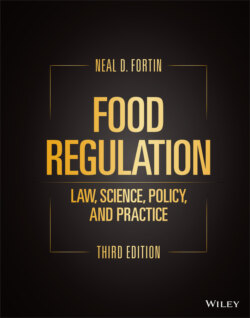Читать книгу Food Regulation - Neal D. Fortin - Страница 242
5 HEALTH CLAIMS 5.1 BACKGROUND
Оглавление* * * * *
Staking a Claim to Good Health. FDA and Science Stand Behind Health Claims on Foods
Paula Kurtzweil, FDA CONSUMER, SPECIAL ISSUE, Focus on Food Labeling
Health claims authorized by the Food and Drug Administration are one of several ways food labels can win the attention of health‐conscious consumers.
These claims alert shoppers to a product’s health potential by stating that certain foods or food substances—as part of an overall healthy diet—may reduce the risk of certain diseases. Examples include folic acid in breakfast cereals, fiber in fruits and vegetables, calcium in dairy products, and calcium or folic acid in some dietary supplements. But food and food substances can qualify for health claims only if they meet FDA requirements….
Although food manufacturers may use health claims to market their products, the intended purpose of health claims is to benefit consumers by providing information on healthful eating patterns that may help reduce the risk of heart disease, cancer, osteoporosis, high blood pressure, dental cavities, or certain birth defects.
What Is a Health Claim?
Health claims are among the various types of claims allowed in food labeling. They show a relationship between a nutrient or other substances in a food and a disease or health‐related condition. They can be used on conventional foods or dietary supplements.
They differ from the more common claims that highlight a food’s nutritional content, such as “low fat,” “high fiber,” and “low calorie.” …
Health claims can include implied claims, which indirectly assert a diet–disease relationship. Implied claims may appear in brand names (such as “Heart Healthy”), symbols (such as a heart‐shaped logo), and vignettes when used with specific nutrient information. However, all labels bearing implied claims must also bear the full health claim [that is, the complete language required by the regulation].
Public Confidence
Health claims became a hot issue in the 1980s, when food marketing strategies began reflecting increased recognition of the role of nutrition in promoting health. At that time, some of the claims used were considered misleading, and many consumers began to doubt their truthfulness. [The Nutrition Labeling and Education Act of 1990] NLEA’s intent, in part, was to rein in exaggerated claims by reinforcing FDA’s authority to regulate health claims and to require that claims be supported by sufficient scientific evidence.
According to an FDA study, consumer confidence in health claims grew in the months following implementation of NLEA….
* * * * *
